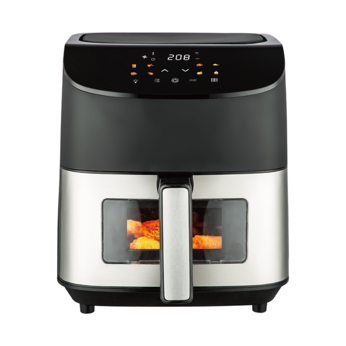Convection Technology and Uniform Heat Distribution
The core principle behind multi-function air oven’s even cooking is convection technology. Unlike traditional ovens that rely solely on radiant heat from heating elements, convection systems use a high-speed fan to circulate hot air evenly throughout the oven chamber. This continuous movement of air eliminates temperature gradients that typically occur in conventional ovens, ensuring that the heat reaches every surface of the food. When multiple trays are stacked, convection airflow ensures that the items on the top, middle, and bottom layers receive the same amount of heat simultaneously. The result is consistent browning, uniform texture, and thorough cooking across all trays. Advanced models also include reverse airflow or multi-directional fan designs, which further minimize hot or cold spots, making them highly effective for complex cooking tasks.
Precision Temperature Sensors and Real-Time Control
Multi-function air ovens incorporate digital temperature sensors strategically placed within the chamber to continuously monitor the internal environment. These sensors detect even minor fluctuations and provide feedback to the heating elements, allowing real-time adjustments to maintain a stable target temperature. This capability is particularly important when multiple trays are loaded, as the additional mass can temporarily lower the internal temperature. By automatically compensating for these variations, the oven ensures that every tray cooks at the intended temperature. Some ovens feature multi-point sensing systems, where multiple sensors monitor different areas of the chamber simultaneously, providing enhanced accuracy for large or unevenly loaded cooking setups.
Multi-Zone Heating for Customized Temperature Control
Some multi-function air ovens use multi-zone heating elements, where separate top, bottom, or side heating units can operate independently. This allows the oven to adjust heating intensity in specific zones depending on the location of the trays or the types of food being cooked. For example, a tray containing delicate pastries can receive gentler top heat to prevent burning, while a tray of roasted vegetables receives stronger heat for caramelization. Multi-zone heating enables users to cook different types of food simultaneously without compromising the texture or doneness of any layer. This feature also allows precise adjustments for recipes that require slight temperature differences across layers, a capability highly valued in professional kitchens.
Airflow Management and Internal Baffles
Effective airflow management is a critical component of achieving uniform cooking in a multi-function air oven. The oven chamber includes internal baffles, vents, and air guides designed to direct hot air evenly around each tray. These structures prevent pockets of stagnant air and ensure that heat circulates uniformly from the fan to all corners of the chamber. By carefully controlling airflow patterns, the oven maintains consistent temperature exposure for every tray, including those located at the top or bottom. This is particularly important when cooking multiple layers of dense or moisture-heavy food, which can otherwise block airflow and lead to uneven results.
Tray Placement and Rotation Guidelines
Even with advanced airflow and temperature controls, tray placement and rotation play an essential role in achieving optimal cooking results. Manufacturers provide specific guidelines for the spacing of trays to allow sufficient airflow between layers. Users are often advised to rotate trays periodically during long cooking sessions, especially when cooking large quantities or dense food items. Proper placement ensures that each tray receives equal exposure to circulating heat, while rotation mitigates any slight variations caused by the natural airflow dynamics of the chamber. Following these recommendations ensures that the oven’s precision systems work effectively.
Preheating and Adaptive Cooking Algorithms
Many multi-function air ovens include preheating functions to bring the oven to the desired temperature before food is introduced. This ensures that cooking begins under stable conditions, avoiding temperature drops caused by cold food entering the chamber. Advanced models employ adaptive cooking algorithms, which monitor factors such as load size, tray number, and food type to adjust heat and fan speed dynamically. For instance, if multiple trays of food are added simultaneously, the oven temporarily increases airflow or heating intensity to compensate for the thermal load, then stabilizes once the target temperature is reached. This feature is crucial for maintaining consistent cooking outcomes across all layers.


 English
English 中文简体
中文简体 English
English 中文简体
中文简体
















